
Treehoppers and thorn bugs are members of the family Membracidae, a group of insects related to the cicadas and the leafhoppers. About 3,200 species of treehoppers in over 400 genera are known. They are found on all continents except Antarctica; only five species are known from Europe. Individual treehoppers usually live for only a few months.

Nycteribiidae is a family of the true fly superfamily Hippoboscoidea are known as "bat flies", together with their close relatives the Streblidae. As the latter do not seem to be a monophyletic group, it is conceivable that bat flies cannot be united into a single family.

The Auchenorrhyncha suborder of the Hemiptera contains most of the familiar members of what was called the "Homoptera" – groups such as cicadas, leafhoppers, treehoppers, planthoppers, and spittlebugs. The aphids and scale insects are the other well-known "Homoptera", and they are in the suborder Sternorrhyncha.

The superfamily Membracoidea of sap-sucking true-bugs includes two of the largest families within what used to be called the "Homoptera": the leafhoppers (Cicadellidae) and the treehoppers (Membracidae). The other families in this group are quite small, and have, at various points, generally been included as members within other families, though they are all presently considered to be valid, monophyletic groups. The relict family Myerslopiidae is restricted to New Zealand and South America while the Melizoderidae consist of two genera restricted to South America. The great diversity of Neotropical taxa suggests that the group originated in that region.

Stictocephala is a genus of treehoppers in the family Membracidae; in the subfamily Smiliinae and tribe Ceresini. Species appear to be distributed mostly in North America, but S. bisonia has become widely distributed in Europe.

Pelodiscus is a genus of turtles in the family Trionychidae, the softshells. Based on genetic and morphological analysis there are seven valid species. They are native to Eastern Asia, ranging from the Amur region, south through China and Korea, as far south as Vietnam. Populations in Japan are thought to likely originate from historic human introductions.
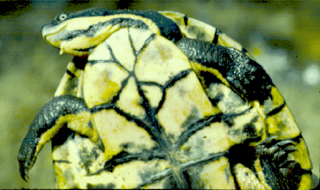
The Myuchelys is a genus of turtles, the Australian saw-shelled turtles, in the family Chelidae and subfamily Chelodininae. They inhabit the headwaters and tributaries of rivers within their range and this led to the name Myuchelys, which is formed from the Aboriginal word myuna meaning clear water and the Greek chelys meaning turtle. They have a short neck and the intergular scute completely separates the gular scutes. They have no alveolar ridge separating them from the snapping turtles of the genus Elseya.

Formica incerta is a species of ant found in eastern North America. It is the most common species of Formica in many areas, and excavates underground nests with small entrance holes. Its diet includes nectar produced by extrafloral nectaries and honeydew, which it obtains from aphids and treehoppers. It is the main host for the slave-making ant Polyergus lucidus. F. incerta was first described by Italian entomologist Carlo Emery in 1893. Its specific name comes from the Latin incertus meaning "uncertain" and seems particularly apt given the subsequent uncertainty as to the validity of the species and the difficulty in distinguishing this ant from other species living in the same area.

Enchenopa binotata is a complex of multiple species found mostly in Eastern North America, but have also been reported in Central America. They are commonly referred to as treehoppers and are sap-feeding insects. The species in the complex look similar to each other in morphology, but are identified as different species by the host plant they occupy.
Epiperipatus machadoi is a species of velvet worm in the Peripatidae family. This species is dark brown with a series of light brown arcs on each side forming circles down its back and ranges from 20 mm to 66 mm in length. Males of this species have 27 to 29 pairs of legs, usually 28; females have 28 to 31, usually 31. The type locality is in Minas Gerais, Brazil.
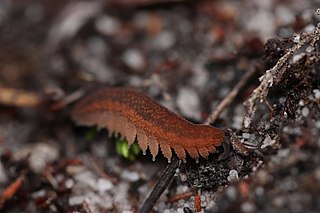
Peripatopsis lawrencei is a species of velvet worm in the Peripatopsidae family. This species has 18 pairs of legs: 17 pregenital leg pairs plus one last pair that is strongly reduced and without claws or spinous pads. This species is restricted to the Theewaterskloof-Overstrand region of South Africa.
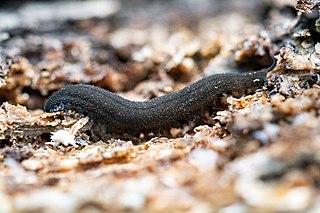
Peripatopsis overbergiensis, the Overberg velvet worm, is a species of velvet worm in the Peripatopsidae family. This species usually has 19 pairs of legs: 18 pregenital leg pairs plus one last pair that is strongly reduced and without claws or spinous pads. Some individuals, however, have only 18 leg pairs. This species is limited to the Overberg region of South Africa.

Smiliinae is a subfamily of treehoppers in the family Membracidae. These are bugs and include about 100 genera in 10 tribes.

Thelia is a genus of treehoppers in the family Membracidae. There are at least two described species in Thelia.
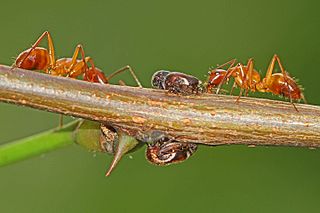
Vanduzea is a genus of treehoppers in the family Membracidae. There are about 12 described species in Vanduzea. The genus was named after American entomologist Edward Payson Van Duzee.
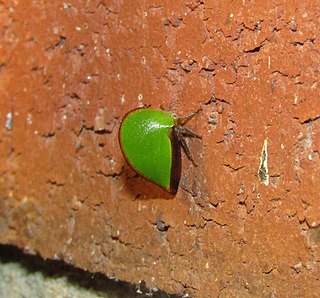
Archasia is a genus of treehoppers in the family Membracidae.

Kaikaia is a genus of treehopper endemic to Nicaragua, containing the single species Kaikaia gaga. It was described in 2020 by Brendan Morris, a Ph.D. student at the University of Illinois at Urbana-Champaign. It entered the news when it was revealed that the insect was named after Lady Gaga.

Stictocephala alta is a species of treehopper in the family Membracidae.
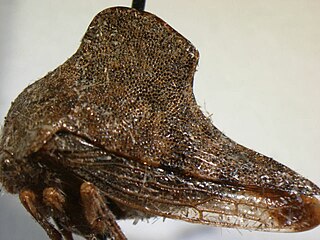
Telamona agrandata is a species of treehopper in the genus Telamona.
Trachytalis distinguenda is a species of treehopper in the family Membracidae.
















